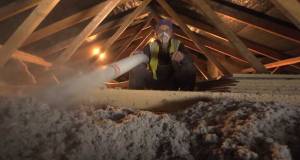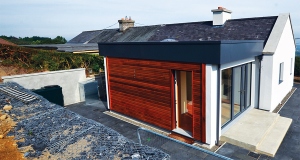- Design Approaches
- Posted
Lofty Ideas

Converting attic space can provide a relatively low cost means of increasing useable space, relative to the more arduous options of extending, or moving to a larger building.Duncan Stewart speaks to Construct Ireland about how best to approach Attic Conversions.
Waste of space in an attic space is a huge missed opportunity. It’s a pity that so many houses built today don’t have attics that can be converted later. That to me is a missed opportunity in practically all of the 60,000 or so houses a year being built in Ireland. This is certainly typically the case with houses built by spec builders and developers, who don’t provide the opportunity for subsequent development. When building a new house, building in such a way that the attic can be converted adds only minor costs, and will be a great help when the owner decides to convert the attic, in terms of overcoming planning, reducing costs, and complying with the building regulations. There’s very little cost in doing that basic work, such as providing the headroom, floor structure, and somewhere for a stairs to go later, that can be designed to comply with fire regulations. These are basic things that are missed in house building all the time. From a sustainability point of view, we need to provide houses that can adapt over time, and can accommodate the needs of families, so the life cycle, or use of that building can go on. If an attic is convertible, it allows the possibility of two families living in a house, such as with elderly parents living on the lower level, and a young family occupying the first floor and the attic space. That adaptability is typically missed.
However if you have a house, and there is an opportunity to convert the attic space, it makes so much sense. It’s the first space to look for if you want to expand.
If you look at the other options, you either move to a bigger house, or build another house, or you extend the existing house. The problem with extending, unless you’ve got a garage you can convert, is that usually the extensions are going to compromise the house in terms of daylight, and in terms of enjoyment of the garden for the existing rooms, because those rooms become compromised by extensions. Within a typical plot, whether it’s a semi-d, an existing house in the country or an older house, it is easier to go up into the roof space.
Daylight
When thinking about daylight, and windows, it’s important to avoid compromising the privacy of adjoining neighbours. There is of course the advantage of an extra view from a higher point, but one has to consider the private aspects of overlooking other people’s properties. This is only an issue at the back of houses, or at the sides. There can be ways around this, with skylight windows, because of their higher mounting and aspect, which don’t cause this problem. When you’re carrying out this work in an existing residential area, how do you get the light and the benefit of the views and ventilation through windows without taking from your neighbours.
The other issue regarding daylight relates to windows at the front, which do require planning permission, as do any material changes to the front of a house.
The big advantage with a roof is that you have the hemisphere of the sky above you, so you have huge opportunities of very good daylight to bring to that space. This can lead to real solar benefits. Predominantly these windows should be south facing, to get the passive solar benefits into that space, rather than north facing, which would lead to losses out rather than gains in. Larger windows on the south roof slope, if possible should be opted for. At the same time, during the summer months you have to avoid the roof over heating.


Insulation
It is important to insulate roof areas very well, not just to protect from cold weather in the winter, and in order to comply with the Building Regulations, but also to avoid the overheating implications of too many gains through the roof as slates heat up in the summer. Slate can heat up to 50 or 60degrees Celsius on a hot day, and good insulation helps to prevent this affecting the internal environment.
If it’s a well insulated roof space, any solar gains in the summer will heat up that environment because you don’t lose energy through the roof structure.
Ventilation becomes very important, and in particular cross ventilation, with at least two windows in the roof space, preferably on opposite slopes of the roof, to create an air movement. It’s very important in attic spaces, to avoid the problems of overheating, when overheating happens. Good insulation and good cross ventilation are important factors in this regard.
One of the big problems in attics relates to how you insulate. Most attics that can be converted have the old bituminous roofing felts, which don’t breathe. They’re like vapour barriers on the wrong side. Then you need ventilation. You have to bring your insulation, keep a clear gap between that membrane, and have eaves ventilation, and ridge ventilation. You need ventilation so your insulation is kept 50mm away from the roofing felt. Usually rafters are only about 5ft or 4 ½ ft or they might be trussed rafters. The requirements under the building regulations on insulation are 0.16 watts per M2 K. That requires 10 to 12 inches of insulation, if you’re using rock wool, glass wool, or mineral wool insulation. Obviously there are higher performance insulations, but whatever way you do it, you’ll still need at least 6 to 8 inches, even if it’s the highest performing insulation. So you’ve lost 2 inches of 50mm, and you have the remainder of the rafter to tightly build insulation between, but you have to insulate underneath again, which loses you headroom. When people are fitting insulation between rafters it’s so important that it’s cut very tight, with no gaps. Gaps between the insulation leads to thermal looping, which causes the insulation to become very ineffective. Good workmanship is key, otherwise you won’t get the benefits of the insulation, regarding insulation between and under the rafters. Otherwise it means taking off the slates or tiles and the roofing felt, building up additional insulation over the rafters, and then adding over that a breathing membrane, such as a Solitex or Tyvek membrane, with ventilation to the outside. In that case you won’t need eaves ventilators or lose space.
If you insulate the attic well, at least better than the existing ceiling, so that the extra space you’ve gained above is not increasing but is rather reducing the amount of heat loss, then at least an existing boiler will have no problem in delivering the extra heat. Through having no increase in heat needed, you don’t put further demands on the boiler, so you don’t have to consider replacing the boiler to increase the capacity.
When you’re insulating an attic, you’re insulating between the rafters, up the slope of the roof. If you have limited headroom, and every inch matters, you’re losing potential space as you have to leave a 2 inch layer for ventilation, if you have bituminous roofing felt that doesn’t breathe. You can insulate between and underneath the rafters, which restricts your headroom even further to the extent that it’s unworkable. One of the options in an attic that should be considered is stripping off the roof tiles or slates, temporarily protecting the roof, and then fitting insulation above the rafters. There are many types of insulation for above rafter conditions, which would be called warm roof construction. This is an option that should be considered if headroom is a major issue. If you take off slates or tiles to do this work you need to protect the roof from inclement weather during conversion work, as the house becomes exposed. This actually isn’t as big a job as people might think. It’s small in the overall context of a conversion. Health and safety is also crucial. Insurance in terms of public liability and employer’s liability must apply for this type of work.
Draught Sealing
With a room in the roof, you’ve got to be very careful in dealing with wind infiltration in windy, cold winter nights. If you think of the layers of a roof, you’ve got slate or tiles, typically a felt which has gaps in it—a better option would be a breathing membrane—and you have rafters with insulation between them, and a vapour check on the inside of the insulation. With insulation, the airtightness of the vapour check becomes very important. It’s so important that on the roof side of the insulation, this membrane seals in to meet the windows, and is continuous.
Anywhere where there is habitable space, the membrane protects against air driving in, and convecting into the roof space, with all the vapour that will condense and form interstitial condensation. The membrane protects against that so that the timbers are not exposed to rot.
With air tightness, you drive air through the structure from the inside through to the outside, which is trying to convect and diffuse through the structure. You're trying to protect that happening, but you're trying to allow the roof to breathe outwards, and at the same time you're trying to stop the wind infiltration coming in. This is one of the big problems with attics. Usually, in 99% of cases, you've got slates or tiles, and in a windy night, wind will whistle through them, or through the eaves. You then get the problem of wind infiltration and you have to protect the building from this. Wind tightness and air tightness are among the high priorities to be dealt with. Wind tightness protects against wind infiltration from the outside, whipping out the heat, cooling the room, and causing huge draughts in the room.

Headroom
Headroom is an issue. To comply with the Building Regulations in terms of habitable space, 50% of the floor area above 1,500mm—which is 5 ft—should be at least 2.4metres, or 8 ft. That usually doesn't apply with attics. There are not enough attics built with sufficient pitch on the roof to allow for that type of condition to apply. In my view, this regulation is very restrictive and unfair. If you want your conversion to comply with building regulations, that factor needs to be dealt with. You can get dispensation, through an Bord Pleanála, for this if you can't meet the headroom requirements. In my view, the Building Regulations should be modified, or updated to allow for this, because you don't need 8 ft headroom. This requirement came in from an old building bylaw, introduced in 1948, and it came from old health acts, because of congested buildings and so on. It's an outdated concept. 8 ft in an attic is not necessary, and 7 ft gives most people adequate comfort. Anything less than that becomes a problem. It's unfortunate because if you convert your attic, and you later sell your house, an architect coming in to inspect the house will point out that the conversion doesn't comply. Therefore habitable space in the attic becomes an issue, thanks to outdated regulations.
Structure
Flooring is an important structural issue, because an attic conversion means considering floor loads, and you need to make sure that the floor complies with the Building Regulations in terms of structure. Usually, ceiling joists in an attic are not good enough for the spans they're supporting below. Typically they're spanning over rooms that might be 12 or 13 ft wide, and are only capable of taking plastered ceilings. They're not usually designed for taking room loads, which means the floor needs to be stiffened up. A lot depends on whether the attic is a trussed rafter attic, with a forest of trussed rafters, with bracing cutting across the space, making it unusable. However, if you have trussed rafters, there are ways of modifying the roof that can replace the trussed rafter structure, by putting in a whole engineered solution that opens up the space. You should have a structural engineer designing and overseeing this work, who would sign and certify the work. So many of the attics that can be converted have these stupid trussed rafters in place, which are just put in because the builder wants to build as cheaply and quickly as possible. In my view this is so wrong, because it really makes it more expensive for householders to convert their attic. Otherwise, putting in additional, larger floor joists spanning across is an option, but it does involve raising the floor level of the attic. In the vast majority of cases, the existing ceiling joists won't be capable of requiring with the structural requirements of floors.
Sound insulation comes in at this point too, as the floor will need to prevent sound from transferring between the converted attic space and the rooms below.
When bringing in attic windows, be they dormer windows or roof windows, this involves trimming the rafters and so on, to open up voids for windows. This trimming has to be structurally correct, and your architect or engineer should be looking at that. There are a lot of competent builders who can do this, but you're at risk if you don't know whether the builder is capable in this regard. Also, bringing in windows involves cutting into the roofing, and the roofing felts and so on, and it's important that you're not creating problems of water leakage with these voids. VELUX are good because they have a service for this.
Fire Safety and Means of Escape
If you're introducing a third floor to a typical 2 storey house, it becomes a lot more onerous than adding a conversion to a bungalow, for example. With a bungalow, you're only adding a first floor, which means you have some means of escape through first floor windows. You don't have this option from a second floor. By introducing a second floor, the building regulations become a lot more onerous. The critical issue is that the main staircase of the house, as a final means of escape, is protected, so that if a fire develops in the lower floors of the house, anyone sleeping in the converted attic can escape. The protection of the stairwell, especially from rooms such as kitchens, into the ground floor, becomes critical. The staircase must comply, as a means of escape. You can't just have an attic ladder as a means of escape. You can get dispensation for the likes of spiral staircases, which may not normally comply with building regulations. However, because with an attic, it's just a single room, you can apply for dispensations. The issue is whether you can design a staircase from your upper floor into the attic that complies, whilst protecting the stairwell.
Opening the staircase up can also offer the possibility of a roof window in the roof space, throwing light down into the existing hallway, so you can bring more light down into the existing floor level.
It's also important that there is a properly wired fire alarm system throughout the house. Just having smoke detectors in a converted attic is not good enough. You need a wired system so that if a fire develops on the ground floor, the alarm will trigger on the top floor, and will be audible enough to alert you. The biggest problem with attic conversions is the risk of fire, not so much in terms of the fire spreading into the space as cutting off the means of escape. The quick alert to fire through a smoke detector system wired through the house, with detectors in the landings, horizontally in the ceilings, and a heat detector in the kitchen and so on, is crucial.
Additionally, as in the rest of the house, the floor must be properly protected, with a properly fire-protected ceiling separating the first floor from the attic.
Energy/Active Measures
There are obvious opportunities for passive solar gains, through roof windows, for instance, with a south facing orientation. High performance glazing is also important in that you can reduce the amount of heat losses at night-time. The same applies to dormer windows.
Because you're converting the attic, you've increased the floor space of the house, and you've increased the energy demand of the house. If it's very well insulated, it might be that you haven't created much of an extra demand for energy. However you have the advantage of being able to put solar collectors on the roof, and it has become very cost effective to do this. With oil prices going up—and they will continue to go up—if you take a ten year payback plan for your solar collectors, you should be looking at a twenty year plan, knowing that it's all free energy you'll be getting once you install it. This is relative to oil prices that are going to be rising and rising and even maybe not available downstream. This is even before you've taken into account the effects that energy labels for houses will have.
Looking at it now, in terms of applying for a mortgage for a conversion, and adding a solar collector as part of the mortgage, you'll probably find that it's incredibly cost effective, in terms of payback. If you were to invest in stocks and shares, you'd probably find that investing this into your home, it's a better investment. By adding the extra costs—it might be €5,000 or €6,000—as part of a mortgage you're paying back over 20 years, you'll probably find that it's the best performing investment that you've made, along with the insulation you've put up there.
With an attic conversion, if you're looking at achieving a good energy label, by improving the overall energy performance of the house, and its not practical to upgrade the walls because of expense and other problems, you can look at using the roof as an opportunity to effect the overall heat loss of the building. This can be a matter of over-compensating with the roof, to help the overall U-value or energy rating of the building. It's a question of compensating for the parts of the building that you can't really upgrade.
Water Pressure
In Ireland and Britain, we still have this concept of housing a water storage tank in the attic, which other Europeans wouldn't have. Europeans tend to pressurise their houses, so there is no need for the water storage to be up in the attic. Usually it is better to go for a pressurised system if you want to have a bathroom or shower in the attic space. However there are problems with having water storage tanks in a typical attic, as the water has to be kept at certain temperatures, for instance to prevent Legionella—the cause of Legionnaire's disease—from developing within the water. The water temperature must be kept low enough, but not so low that it can freeze. Usually in Ireland, it's kept outside the insulated envelope of a house. If the tank is in the attic, there should be some way of insulating it against the roof temperatures. The tank itself should be insulated, so that it doesn't reach high temperatures. Also, the tank should be placed so that it doesn't disrupt the use of space in a converted attic. Tanks are often placed in an area where they are obstructive, on the basis that the higher the tank is, the better the water pressure will be for the showers in the lower floors. Unless you go for a pressurised system with a pump for the whole plumbing system in the house, the positioning of that tank becomes an issue.
Design
There are design and architectural factors that come into an attic conversion too that one should look at. How can you carry out this work in a way that aesthetically enhances the house, but is compatible with the existing architecture of the house and sympathetic to the rest of the street? These factors should be addressed in terms of the external treatment, so that you don't end up with something that just looks like a hotch-potch. For instance, if adding solar collectors to the roof, it's important to consider how they can be integrated into the roof, and designed in a complementary way.
You should use an architect, and make sure that you comply with planning and building regulations, and get the benefit of design. At the end of the day, if you want to sell the house, you should have a certificate of compliance from the architect.
- attic conversions
- loft insulating
- attic space
- Duncan Stewart
- insulating attics
- velux windows
- sheeps wool insulation
Related items
-
 Don’t neglect simple attic insulation — Ecocel
Don’t neglect simple attic insulation — Ecocel -
 Ecocel praises Cork City Council’s cellulose approval
Ecocel praises Cork City Council’s cellulose approval -
 Passive House Plus editor explains passive house to RTE's Eco Eye
Passive House Plus editor explains passive house to RTE's Eco Eye -
 Dublin hillside rebuild tackles low energy in stages
Dublin hillside rebuild tackles low energy in stages -
Oil days are over
-
Heating need not cost the Earth
-
Health in the home
-
Chernobyl Childrens Project
-
Conservation + Sustainability
-
Coillte Teoranta

